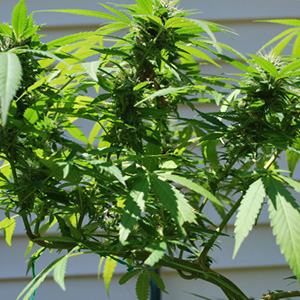In this contributor article, Amy Zukeran of Amy’s Cannabis Garden explores how cannabis can be used to help treat Lyme disease.

The following is an article produced by a contributing author. Growers Network does not endorse nor evaluate the claims of our contributors, nor do they influence our editorial process. We thank our contributors for their time and effort so we can continue our exclusive Growers Spotlight service.
Ah, the great outdoors! Fresh clean air, a freshly rolled blunt, and the sun gently caressing your face. Every step is an adventure as you hike deeper into the woods. But there is something small and fast stalking you through the grass and you better do something about it. Ticks love tall grass, and it’s even better to hitch a ride on you, the human. And these ticks carry the bacteria that causes Lyme disease to the tune of 30,000 new infections every year in the U.S.
Borrelia burgdorferi causes Lyme disease and is carried by the Ixodes genus of ticks. The disease is especially prevalent in the Northeastern U.S. though it occurs in half of the 3,110 counties in this country. This bacterium can switch modes, which makes it difficult to detect and kill. It has a double membrane envelope and tends to hide in deep tissue. It can also change shapes to disguise its identity.
Left untreated, 60 percent of patients develop pain and swelling at joints after a few weeks. This pain can last for days or months and is known to move from one side to the other.
Stages of Infections
Initially, an infection may seem like the flu – fever, chills, swollen lymph nodes, fatigue, headaches, body aches, and muscle stiffness. Check the bite site. If there is a bullseye marking circling the bite, get thee to a doctor. This is early stage and antibiotics can help.

In the second stage of the disease, heart and nervous system problems can arise. Ten percent of sufferers will experience abnormal heart rhythms. A stiff neck and severe headaches may be an indicator of meningitis so visiting a doctor is highly advisable. Also, there may be abnormal sensations in limbs that can last days to months and shifts from one joint to another.
The third stage can result in motor and sensory nerve damage and brain inflammation. Studies have shown that Lyme disease patients have a higher rate of anxiety and depression. There’s also a host of possible symptoms such as changes in mood or sleeping pattern, difficulty concentrating, fatigue, and memory loss. Serious cognitive problems.
Cannabis and Lyme Disease
So where does medical marijuana fit into this miasma of symptoms? Most of this early research is based on anecdotal evidence and the reader is reminded that we are all different physiologically when it comes to drug sensitivity. ”Low and slow” is the way to go when first experimenting with cannabis.
Smoking is not the most efficient delivery system of all the healing chemicals in cannabis but it is useful for its anti-nausea, pain relief, mood stabilizing, and appetite stimulating effects. The best way to get the most benefit from cannabis is to eat it.
Cannabis oil is a concentrate from marijuana created through an extraction process. It typically has a good balance of THC and CBD, which most experts agree work synergistically to achieve optimal effects.
THC, tetrahydrocannabinol, is the compound in cannabis that imparts the “high”, cerebrally stimulating quality. CBD, or cannabidiol, is the compound that has the muscle-relaxing, pain relieving, and anti-seizure qualities. CBD is also great for latter stage symptoms as pain, spasms, nausea, headache, and peripheral neuropathy.
Currently, CBD paste is being studied for its antibiotic characteristics by an undisclosed university in the U.S. All five major cannabinoids have been shown to kill MRSA, the highly infectious hospital-borne illness.
Medical Marijuana -- Useful Qualities
In Shelly White’s book, “Cannabis for Lyme Disease and Related Conditions,” she enumerates the benefits of medical marijuana for chronic diseases:
- Cannabis molecules are antimicrobial and show anti-parasitic activity.
- Cannaflavins, compounds found in most plant life, are more effective than aspirin as an anti-inflammatory.
- THC also has medicinal qualities. It can act as an anti-inflammatory, anti-nausea, anti-epileptic, appetite stimulant, blood thinner, anti-cancer, glaucoma reducer, and pain reliever.
- Stimulates dopamine and serotonin release that increases pain relief and improves outlook
- Decreases brain inflammation called Lyme encephalitis
- Prevents cell damage and known as a powerful antioxidant
- Improves anxiety and depression moods by activating serotonin receptors
- Muscle relaxant, DNA protectant, and anti-arthritic
- Effective for migraines; brain fog, and insomnia
10 Best Gift Ideas for Cannabis Connoisseurs and Growing Aficionados (2022)
December 7, 2022Developing and Optimizing a Cannabis Cultivation System
December 14, 2021Dealing with Insomnia: How Can CBD Help?
December 10, 2020Your Guide to Sleep and CBD
December 7, 2020
Do you want to receive the next Grower's Spotlight as soon as it's available? Sign up below!
Resources:
Want to get in touch with Amy? She can be reached via the following methods:
- Website: http://amys-cannabis-garden.com/

Do you have any questions or comments?

About the Author
Amy was born and raised in the Puna Bud Capital of the World -- Hawai'i. She is genetically programmed to write and also explore medical cannabis so visit her blog. Mahalo Nui Loa!